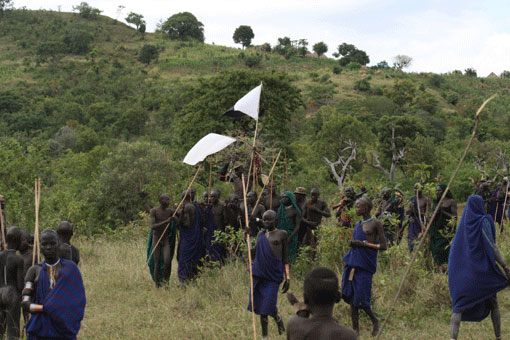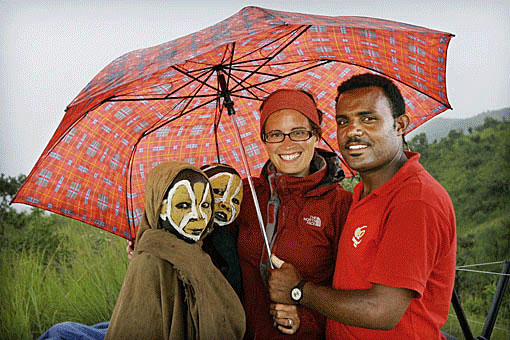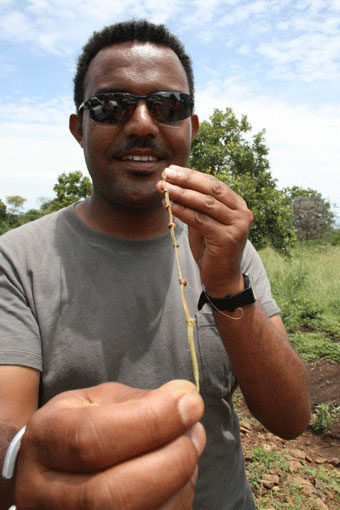A Grass Calendar
Jane Atkins, Researcher, Deserts/Grasslands team.
A waving white flag is usually a sign for peace, but in the Omo valley it was quite the opposite. In a vast valley of green grasslands and leafy trees these bright flags stood out as bold signs announcing that a violent stick fight was being planned between two villages. It was these incredible stick fights, or Dongas that we hoped to film - but finding out exactly when they would happen was a bit trickier! With only a ten day shoot in this massive valley that stretched to Sudan, we had to find out when each Donga was taking place, and if the chiefs of each village were happy for us to film.

White flags waving
Luckily we were working with Zablon Beyene, an incredible person and wonderful fixer, who introduced us to wise old chiefs and proud confident warriors with smiles.

Zablon and I share our umbrella
Over a 5 day recce we walked through villages and valleys to meet Suri elders, sat under shady trees in the heat of the day to talk to young fighters, and sketched out a badly drawn and dusty map of which villages were planning Dongas.
Sitting on the grass, with my map in my dirty hands, we just needed to mark it according to our western agenda of time. Diary planning and meeting deadlines becomes second nature in TV, but here dates were less clear, even to Zab! When we asked the chief when the Donga would happen he picked a long stem of grass, and with dark, leathered hands and tied evenly spaced knots. He explained how each knot represented one day, so the grass stalk handed to us with 8 knots meant the Donga would be on the 8th day. With slight apprehension I translated the dates onto my map, and thanked the chief. Now, after hundreds of handshakes and Suri meetings, all that remained was getting the camera crew to the right location.

The knotted rope calendar
On the morning of the Donga we walked to the clearing - it was silent, except for the sound of hundreds of dragonflies buzzing around in the sun! 2 hours later, with all our camera kit ready and a crane rigged, we looked at the empty clearing and hoped we’d got the right day after all!
We heard the men coming before we saw them; chants and songs through the trees, getting louder as they approached. Then gun shots! This, Zablon told us, was just guys firing shots into the air to psych themselves up. It worked, as the air was suddenly filled with excitement and adrenaline, as hundreds of men poured into the clearing, waving their sticks. As the crowd circled two posturing fighters, they stabbed a white flag into the ground; the donga had started.
To set the scene our cameraman Mike Fox moved the crane 20 feet into the air to reveal an amazing image of hundreds of men in combat - a scene you’ll never see any where else. We filmed all day, with the crane, then moving hand held amongst the crowds and spectators, and also with an incredible high speed HD camera that captured the force of each fighter. Moving through pumped up crowds, dodging swiping sticks, and ducking from celebratory gun shots were part of the experience and chances we took to film the sequence.
As I led a cameraman into another position I was mistakenly hit by one stick, and as I ran for a new battery I heard the whizzing of a gunshot past my head! The brutality of the Donga really did separate the men from the boys, and was a fascinating insight to the Suri world. As we packed up I was happy that all our planning had paid off, but even happier that we’d all survived!

hey janie,
great website, well done.
What an awesome experience. How wonderful that Human Planet is to be able to share it with the world. Thank You!
Wow, Jane. What an experience. Glad I have read this after the event and know that you have returned safely. Still, working on Human Planet does mean you go to exciting places. Lucky thing. Marilyn